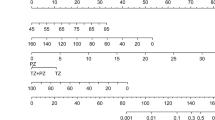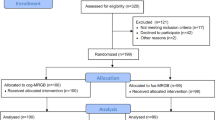Abstract
Purpose
The aim of this study is to assess the precision of the Gleason score (GS) obtained through cognitive fusion-targeted biopsy (COG-TB) in comparison to transrectal ultrasonography-guided systematic biopsy (TRUS-SB), and to identify factors that can predict Gleason score upgrading (GSU) in a cohort of Chinese patients.
Methods
A final enrollment of 245 patients was recorded. Between 2020 and 2022, 132 patients underwent TRUS-SB, and 113 patients underwent COG-TB. The Chi-square test was performed to analyze the variation in downgrading, concordance, and upgrading between TRUS-SB and COG-TB. Multivariable analyses were performed to seek factors predicting Gleason score upgrading. Finally, a model which utilizes multivariable logistic regression was developed to predict the likelihood of GSU.
Results
The concordance for TRUS-SB and COG-TB were 42.4% and 65.5%, respectively. TRUS-SB and COG-TB exhibited notable disparities in downgrading, concordance, and upgrading. Age, prostate volume, body mass index (BMI), and the biopsy modality were significant predictive factors.
Conclusion
COG-TB can significantly increase concordance with final histopathology. Age, prostate volume, BMI, and the biopsy modality were predictive factors of GSU.





Similar content being viewed by others
Data availability
The corresponding authors can provide the necessary data for this study upon reasonable request.
References
Siegel RL, Miller KD, Fuchs HE, Jemal A (2022) Cancer statistics, 2022. CA A Cancer J Clin 72:7–33. https://doi.org/10.3322/caac.21708
Epstein JI, Egevad L, Srigley JR, Humphrey PA (2016) The 2014 international society of urological pathology (ISUP) consensus conference on gleason grading of prostatic carcinoma. Am J Surg Pathol 40(2):244–252
Bokhorst LP, Valdagni R, Rannikko A et al (2016) A decade of active surveillance in the prias study: an update and evaluation of the criteria used to recommend a switch to active treatment. Eur Urol 70:954–960. https://doi.org/10.1016/j.eururo.2016.06.007
Freedland SJ, Kane CJ, Amling CL et al (2006) Upgrading and downgrading of prostate needle biopsies: risk factors and clinical implications. J Urol 175:534–534. https://doi.org/10.1016/S0022-5347(18)33846-1
Ahdoot M, Wilbur AR, Reese SE et al (2020) MRI-targeted, systematic, and combined biopsy for prostate cancer diagnosis. N Engl J Med 382:917–928. https://doi.org/10.1056/NEJMoa1910038
Dong F, Jones JS, Stephenson AJ et al (2008) Prostate cancer volume at biopsy predicts clinically significant upgrading. J Urol 179:896–900. https://doi.org/10.1016/j.juro.2007.10.060
Hong SK, Han BK, Lee ST et al (2009) Prediction of Gleason score upgrading in low-risk prostate cancers diagnosed via multi (> or = 12)-core prostate biopsy. World J Urol 27:271–276. https://doi.org/10.1007/s00345-008-0343-3
Kasivisvanathan V, Rannikko AS, Borghi M et al (2018) MRI-targeted or standard biopsy for prostate-cancer diagnosis. N Engl J Med 378:1767–1777. https://doi.org/10.1056/NEJMoa1801993
Borkowetz A, Platzek I, Toma M et al (2016) Direct comparison of multiparametric magnetic resonance imaging (MRI) results with final histopathology in patients with proven prostate cancer in MRI/ultrasonography-fusion biopsy. BJU Int 118:213–220. https://doi.org/10.1111/bju.13461
Lanz C, Cornud F, Beuvon F et al (2016) Gleason score determination with transrectal ultrasound-magnetic resonance imaging fusion guided prostate biopsies-are we gaining in accuracy? J Urol 195:88–93. https://doi.org/10.1016/j.juro.2015.07.021
Arsov C, Becker N, Rabenalt R et al (2015) The use of targeted MR-guided prostate biopsy reduces the risk of Gleason upgrading on radical prostatectomy. J Cancer Res Clin Oncol 141:2061–2068. https://doi.org/10.1007/s00432-015-1991-5
Diamand R, Oderda M, Al Hajj Obeid W et al (2019) A multicentric study on accurate grading of prostate cancer with systematic and MRI/US fusion targeted biopsies: comparison with final histopathology after radical prostatectomy. World J Urol 37:2109–2117. https://doi.org/10.1007/s00345-019-02634-9
Puech P, Rouvière O, Renard-Penna R et al (2013) Prostate cancer diagnosis: multiparametric MR-targeted biopsy with cognitive and transrectal US-MR fusion guidance versus systematic biopsy–prospective multicenter study. Radiology 268:461–469. https://doi.org/10.1148/radiol.13121501
Gershman B, Dahl DM, Olumi AF et al (2013) Smaller prostate gland size and older age predict Gleason score upgrading. Urol Oncol: Semin Orig Investig 31:1033–1037. https://doi.org/10.1016/j.urolonc.2011.11.032
Herlemann A, Buchner A, Kretschmer A et al (2017) Postoperative upgrading of prostate cancer in men ≥75 years: a propensity score-matched analysis. World J Urol 35:1517–1524. https://doi.org/10.1007/s00345-017-2045-1
Kulkarni GS, Lockwood G, Evans A et al (2007) Clinical predictors of Gleason score upgrading: implications for patients considering watchful waiting, active surveillance, or brachytherapy. Cancer 109:2432–2438. https://doi.org/10.1002/cncr.22712
Richstone L, Bianco FJ, Shah HH et al (2008) Radical prostatectomy in men aged >or=70 years: effect of age on upgrading, upstaging, and the accuracy of a preoperative nomogram. BJU Int 101:541–546. https://doi.org/10.1111/j.1464-410X.2007.07410.x
Sun L, Caire AA, Robertson CN et al (2009) Men older than 70 years have higher risk prostate cancer and poorer survival in the early and late prostate specific antigen eras. J Urol 182:2242–2248. https://doi.org/10.1016/j.juro.2009.07.034
Knight AS, Sharma P, de Riese WTW (2022) MRI determined prostate volume and the incidence of prostate cancer on MRI-fusion biopsy: a systemic review of reported data for the last 20 years. Int Urol Nephrol 54:3047–3054. https://doi.org/10.1007/s11255-022-03351-w
Pierorazio PM, Kinnaman MD, Wosnitzer MS et al (2007) Prostate volume and pathologic prostate cancer outcomes after radical prostatectomy. Urology 70:696–701. https://doi.org/10.1016/j.urology.2007.05.022
Moussa AS, Li J, Soriano M et al (2009) Prostate biopsy clinical and pathological variables that predict significant grading changes in patients with intermediate and high grade prostate cancer. BJU Int 103:43–48. https://doi.org/10.1111/j.1464-410X.2008.08059.x
Davidson DD, Koch MO, Lin H et al (2010) Does the size matter?: Prostate weight does not predict PSA recurrence after radical prostatectomy. Am J Clin Pathol 133:662–668. https://doi.org/10.1309/AJCPPHGXDI94SGAC
Min SH, Park YH, Lee SB et al (2012) Impact of prostate size on pathologic outcomes and prognosis after radical prostatectomy. Korean J Urol 53:463–466. https://doi.org/10.4111/kju.2012.53.7.463
Gao Y, Jiang C-Y, Mao S-K et al (2016) Low serum testosterone predicts upgrading and upstaging of prostate cancer after radical prostatectomy. Asian J Androl 18:639–643. https://doi.org/10.4103/1008-682X.169984
Lorenzo G, Hughes TJR, Dominguez-Frojan P et al (2019) Computer simulations suggest that prostate enlargement due to benign prostatic hyperplasia mechanically impedes prostate cancer growth. Proc Natl Acad Sci U S A 116:1152–1161. https://doi.org/10.1073/pnas.1815735116
Perez-Cornago A, Appleby PN, Pischon T et al (2017) Tall height and obesity are associated with an increased risk of aggressive prostate cancer: results from the EPIC cohort study. BMC Med 15:115. https://doi.org/10.1186/s12916-017-0876-7
Ploussard G, de la Taille A, Bayoud Y et al (2012) The risk of upstaged disease increases with body mass index in low-risk prostate cancer patients eligible for active surveillance. Eur Urol 61:356–362. https://doi.org/10.1016/j.eururo.2011.07.041
Price AJ, Allen NE, Appleby PN et al (2012) Insulin-like growth factor-I concentration and risk of prostate cancer: results from the European prospective investigation into cancer and nutrition. Cancer Epidemiol Biomarkers Prev 21:1531–1541. https://doi.org/10.1158/1055-9965.EPI-12-0481-T
Albanes D, Weinstein SJ, Wright ME et al (2009) Serum insulin, glucose, indices of insulin resistance, and risk of prostate cancer. J Natl Cancer Inst 101:1272–1279. https://doi.org/10.1093/jnci/djp260
Zhang B, Wu S, Zhang Y et al (2021) Analysis of risk factors for Gleason score upgrading after radical prostatectomy in a Chinese cohort. Cancer Med 10:7772–7780. https://doi.org/10.1002/cam4.4274
Funding
No financial support was given for this research.
Author information
Authors and Affiliations
Contributions
TYZ curated the entire project and wrote the article. KPB analyzed the data and produced figures. YQT contributed to project development and writing. YZ and JW collected relevant clinical data. LY supervised the conduct of the study from start to finish and review the article.
Corresponding author
Ethics declarations
Conflict of interest
All authors declare that there are no competing interests or conflicts of interest associated with this research.
Ethical approval
All procedures performed in studies involving human participants were in accordance with the 1964 Helsinki Declaration and its later amendments or comparable ethical standards. For this type of study, formal consent is not required.
Consent for publication
Not applicable.
Additional information
Publisher's Note
Springer Nature remains neutral with regard to jurisdictional claims in published maps and institutional affiliations.
Rights and permissions
Springer Nature or its licensor (e.g. a society or other partner) holds exclusive rights to this article under a publishing agreement with the author(s) or other rightsholder(s); author self-archiving of the accepted manuscript version of this article is solely governed by the terms of such publishing agreement and applicable law.
About this article
Cite this article
Zheng, T., Bi, K., Tang, Y. et al. Cognitive fusion-targeted biopsy versus transrectal ultrasonography-guided systematic biopsy: comparison and analysis of the risk of Gleason score upgrading. Int Urol Nephrol 56, 981–988 (2024). https://doi.org/10.1007/s11255-023-03848-y
Received:
Accepted:
Published:
Issue Date:
DOI: https://doi.org/10.1007/s11255-023-03848-y




